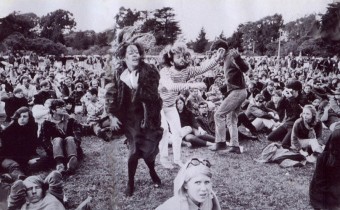This Day in History: January 14th- The Human Be-In
This Day In History: January 14, 1967
 The Human Be-In, or the Gathering of the Tribes, on January 14, 1967 in San Francisco’s Golden Gate Park brought hippies, LSD and psychedelia to national attention. It was the harbinger of the celebrated Summer of Love, and made Haight-Ashbury the epicenter of a growing movement of young people ready to follow acid-dropping Harvard professor Timothy Leary’s advice at the Be-In to “turn on, tune in, and drop out.”
The Human Be-In, or the Gathering of the Tribes, on January 14, 1967 in San Francisco’s Golden Gate Park brought hippies, LSD and psychedelia to national attention. It was the harbinger of the celebrated Summer of Love, and made Haight-Ashbury the epicenter of a growing movement of young people ready to follow acid-dropping Harvard professor Timothy Leary’s advice at the Be-In to “turn on, tune in, and drop out.”
Leary later stated in his autobiography, Flashbacks,
“Turn on” meant go within to activate your neural and genetic equipment. Become sensitive to the many and various levels of consciousness and the specific triggers that engage them. Drugs were one way to accomplish this end. “Tune in” meant interact harmoniously with the world around you – externalize, materialize, express your new internal perspectives. “Drop out” suggested an active, selective, graceful process of detachment from involuntary or unconscious commitments. “Drop Out” meant self-reliance, a discovery of one’s singularity, a commitment to mobility, choice, and change. Unhappily my explanations of this sequence of personal development were often misinterpreted to mean “Get stoned and abandon all constructive activity”.
Along with Tim Leary, many other leading figures of the counterculture were at the Be-In, including Allen Ginsberg, Dick Gregory, Jerry Ruben, and Michael Bowen, who masterminded and organized the event. Popular bands like the Grateful Dead, Jefferson Airplane, and the Quicksilver Messenger Service provided entertainment for the twenty to thirty thousand people estimated to be in attendance. The Diggers handed out free food, and Owsley “Bear” Stanley brought massive amounts of “White Lightning” LSD to the party.
Both the Human Be-In and the hippie movement as a whole was the passing of the torch from the beat poets to the disaffected generation of students living in the San Francisco area at the time. They all shared the same core values – environmental awareness, communal living, liberal political beliefs and the quest for higher consciousness. This transition was personified perfectly by Allen Ginsberg, the beat poet who attended the happening dressed head-to-toe in white, chanting mantras, and dancing with joyous abandon.
Michael Bowen came up with the name “Human Be-In” at another event, the Love Pageant Rally. It incorporated humanist values with the current strategy employed by political activists – sit-ins. The practice had been used throughout the 1960s to protest segregation and outmoded college and university policies. The Human-Be-In was conceptualized to protest the banning of LSD in California on October 6, 1966.
Poet and novelist Michael McClure described the Be-In as:
a spiritual occasion, culminating from the countless preceding events, dances, thoughts, breaths, lovemakings, illuminations. The Be-In was a blossom, it was a flower. It was out in the weather. It didn’t have all its petals. There were worms in the rose. It was perfect in its imperfections. It was what it was and there had never been anything like it before.
If you liked this article, you might also enjoy our new popular podcast, The BrainFood Show (iTunes, Spotify, Google Play Music, Feed), as well as:
- The Major League Pitcher Who Claimed He Threw a No-Hitter While on LSD
- Can Color Blind People See More Colors When They Take Hallucinogenic Drugs?
- FACT OR FICTION?: A Young Bill Murray Was Arrested for Carrying 10 Pounds of Marijuana
- Not Guided By Policy- Hunter S. Thompson and the Birth of Gonzo Journalism
- One of the Most Shocking CIA Programs of All Time: Project MKUltra
Bonus Fact:
LSD, more technically known as Lysergic acid diethylamide was first synthesized on November 16, 1938 by Swiss scientist Dr. Albert Hofmann. Dr. Hofmann was working at the Sandoz Laboratories in Switzerland researching ergot alkaloid derivatives for use in pharmaceuticals. Ergot alkaloid’s are a type of ergoline alkaloid which is found in a certain type of fungus. Ergoline has many medicinal uses, including being used in the treatment of migraines and Parkinson’s disease.
In synthesizing LSD, Dr. Hofmann intended to create a stimulant for the respiratory and circulatory systems. The fact that his creation caused psychedelic effects wasn’t actually known until a full half decade later when Dr. Hofmann accidentally absorbed a small amount of the chemical through his fingertips. He described his first experience with LSD thus:
“…affected by a remarkable restlessness, combined with a slight dizziness. At home I lay down and sank into a not unpleasant intoxicated-like condition, characterized by an extremely stimulated imagination. In a dreamlike state, with eyes closed (I found the daylight to be unpleasantly glaring), I perceived an uninterrupted stream of fantastic pictures, extraordinary shapes with intense, kaleidoscopic play of colors. After some two hours this condition faded away.”
After a significant amount of further study, LSD was eventually introduced as a psychiatric drug starting in 1947. It was also later used in the 1950s by the CIA in Project MKULTRA, where, among other things, the CIA illegally gave LSD to people, including the general public, without their knowing. They then studied the effects with the point of the project to attempt to use various methods, including drugs, torture, etc, to manipulating people’s brain states and functions as way to experiment with potential mind control methods.
LSD wasn’t the only popular hallucinegenic substance Dr. Hofmann was involved with. As director of natural products at Sandoz, he studied various other hallucinogenic substances, successfully synthesizing some of them, such as psilocybin, which is the main ingredient of “magic mushrooms”.
Expand for References| Share the Knowledge! |
|




